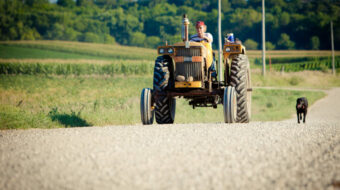More than one environmental crisis threatens our planet. While most of our collective attention is focused on global warming and climate change, the topsoil which sustains life is quickly eroding.
On average, the Earth’s land surface is covered with about 1 meter of topsoil — the nutrient-rich matter which humans use to grow most of our food. But scientists estimate that we are now losing about 1 percent of this topsoil every year to erosion, mostly because of agriculture.
Capitalist dirt problem
In effect, modern capitalist agricultural practices are outstripping the Earth’s natural rate of creating topsoil. The U.S. National Academy of Sciences has determined that cropland is being eroded at least 10 times faster than the time it takes for lost soil to be replaced.
University of Washington professor David Montgomery’s popular book “Dirt” calls public attention to this potential environmental disaster. Montgomery describes modern agricultural practices as “soil mining.”
Healthy topsoil cannot be created quickly. It is a biologically diverse complex of organisms: microbes, fungi, nutrients and earthworms whose digestive tracts transform the fine grains of sterile rock and plant detritus. Topsoil grows back at a rate of an inch or two over hundreds of years.
A growing number of farmers and agricultural scientists are urging “no-till” methods, which involve not tilling the land between plantings, leaving crop stubble to reduce erosion and planting new seeds between the stubble rows. Erosion rates in some areas of North America have improved recently because of better conservation farming practices, but this simply slows the net loss. Meanwhile, the conversion of farmland to urban use continues to exacerbate the problem.
And while no-till farming can reduce topsoil erosion, the switch requires heavy upfront investment and learning new techniques. It also tends to depend more on herbicides because weeds can’t be controlled by plowing them into the soil.
Organic farming methods also can reduce soil loss. Agricultural researchers have found increases in soil health, water retention and regrowth when organic methods replace traditional practices. But the global scale of the problem far outstrips progress made by recent shifts towards organic farming.
Eroding food supply
The world’s worst soil loss trouble spot is sub-Saharan Africa, which faces a combination of some of the world’s worst soils, rapid population growth rates and widespread soil erosion and desertification. Per capita grain production peaked in Africa in 1967, and has declined one percent annually ever since, contributing to the rapidly increasing number of malnourished people.
Other regions are also showing problem signs. The southern portion of the former USSR has been seriously damaged by many centuries of erosion, and half of Russia’s arable land is now unsuitable for farming.
In Canada’s prairie region, wind erosion accounts for twice as much soil loss as water erosion, reflecting attempts to expand cropland into arid lands such as the Palliser Triangle which should never have been farmed intensively. The loss of about half the organic matter from Canada’s prairie croplands over the past 70 years points to a future of decreasing productivity and increased soil erosion.
In the United States, problems include a history of major dams, many of which have captured huge erosion sediments, and the cotton monocultures of the southern states, which eventually forced croplands into pulpwood plantations. Under the Reagan administration, policies to support soil conservation were abandoned in favor of allowing erosion down to the depth of root zones (about 6 inches), when farmers would feel compelled, on their own, to conserve soil. That disastrous policy shift was later reversed, but soil loss remains very serious.
Biofuels burning topsoil
Looking at the issue from a wider capitalist perspective, it is clear that the economic pressures to generate export earnings are directly linked to soil erosion. The process has not been reversed; in fact, the boom in crops for biofuels has been compared to burning off the last few inches of Midwestern topsoil to keep private vehicles moving.
Advocates for biofuels claim that using agricultural “waste” to make fuel can help solve energy shortages and reduce greenhouse gas emissions. They also argue that byproducts of this process can be used to regenerate topsoil.
But this approach has its own problems. Making fuel from unused portions of plants that are normally plowed under increases the need for nitrogen fertilizers, which release the most potent greenhouse gas of all; nitrous oxide. Much of the residual crop biomass must be returned to the soil to maintain topsoil integrity, otherwise the rate of topsoil erosion will increase dramatically. In effect, biofuels are mining our topsoil for energy, and the recycling of byproducts does nothing to reverse the overall danger.
Using wood chips to make ethanol initially sounds like a good way to cut down on the soil erosion problem. But remember that this material is already used to make paper, particleboard, pellet fuel for stoves and many other products. Every part of the trees we cut down for lumber can be used for something, including the bark, which is used for garden mulch.
The huge amounts of wood waste created by current corporate profiteering practices in the forest industry could be used to produce fuel, but in reality, North American forests are already overused producing lumber, let alone liquid biofuels. This strategy has very limited possibilities to reduce the topsoil erosion crisis.
Not so green
Another long-standing capitalist approach is to develop new technologies to expand food resources without requiring more land for cultivation. During the second half of the last century, sharp increases in agricultural productivity were called the “green revolution.” Increased yields were gained by planting monocultures of hybrid crop varieties and by the application of large amounts of inorganic fertilizer, irrigation water and pesticides.
This resulted in dramatic increases in crop yields, first in more developed capitalist countries, and later to the global south, involving the cultivation of new high-yield, fast-growing dwarf varieties of rice and wheat, specially bred for tropical and subtropical climates. However, achieving high yields with these new crops required much larger inputs of fertilizers, water and pesticides.
Today, it now takes about 1.2 barrels of oil to produce a single ton of grain in more developed countries — seven times greater than in 1950! Capitalist industrial agriculture has become addicted to oil, using about 8 percent of world oil output.
As soil fertility declines and the world appears to near the limits of industrial food production, rising prices and hunger are becoming more prevalent. Anger over high food and fuel costs has sparked violent protests in many countries, from “tortilla riots” in Mexico to clashes between villagers and police in India and the arrest of 300 people in landlocked Burkina Faso. The UN World Food Program says staple food prices in some parts of Africa have risen by 40 percent or more in six months.
Is there an alternative?
The scope of the impending soil and food catastrophe raises a critical question: is there an alternative?
One answer comes from socialist Cuba, which was forced to radically overhaul its agricultural system after the demise of the Soviet Union, its main trading partner. Factories closed, food supplies plummeted and the average daily caloric intake of Cubans dropped by a third.
Suddenly without fertilizer, pesticides, fuel and machinery parts, Cuba turned to organic methods, oxen and urban gardens. In 1992, the country’s urban agriculture was virtually zero. By the end of the decade millions of tons of food were being grown with cities making use of every empty space: vacant lots, school playgrounds, patios and backyards.
Cuba created the largest program in sustainable agriculture ever undertaken. By 1999 agricultural production had recovered and in some cases reached historic levels.
Today, Cuba is recognized worldwide as the first country to combine environmental sustainability with social justice. It remains to be seen exactly how Cuban agriculture will continue to develop, but its experience shows that a country can feed its population and begin to restore its soil without depending on traditional capitalist policies.
Here in North America, if the topsoil crisis continues, we may be compelled to consider a similar radical shift sooner than anyone can imagine. In fact, it may be the only way to save the global environment from collapse.
Kimball Cariou is the editor of People’s Voice (www.peoplesvoice.ca), published by the Communist Party of Canada. This article is reprinted from People’s Voice.









